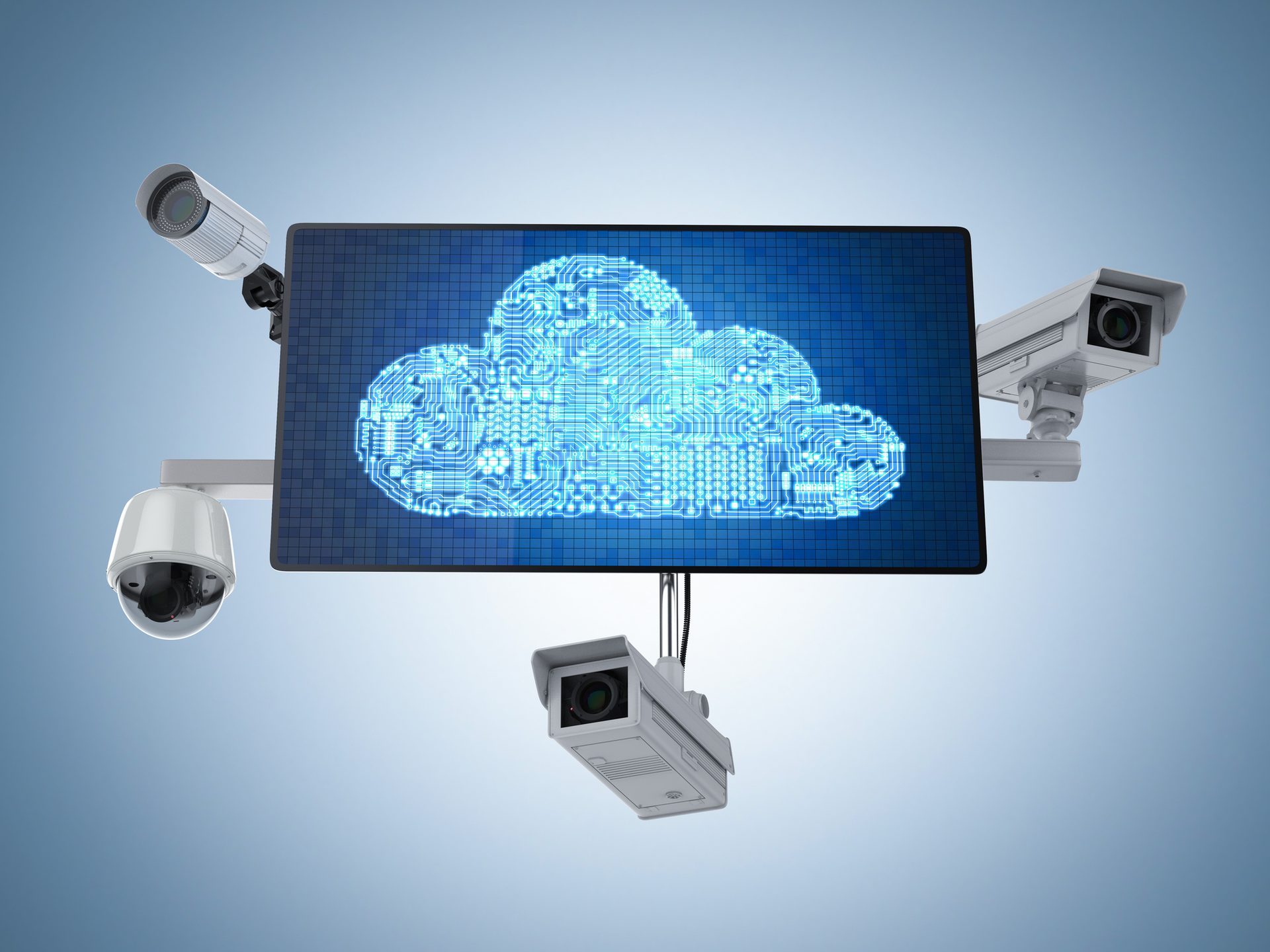sepetember 2025
// Security Intercoms
Your Intercom’s Performance in Any Environment
Delivering clear, consistent audio depends on choosing equipment with the right features and carefully designing the setup to match each space’s acoustic properties.
By Laura Stepanek, SDM Contributing Writer
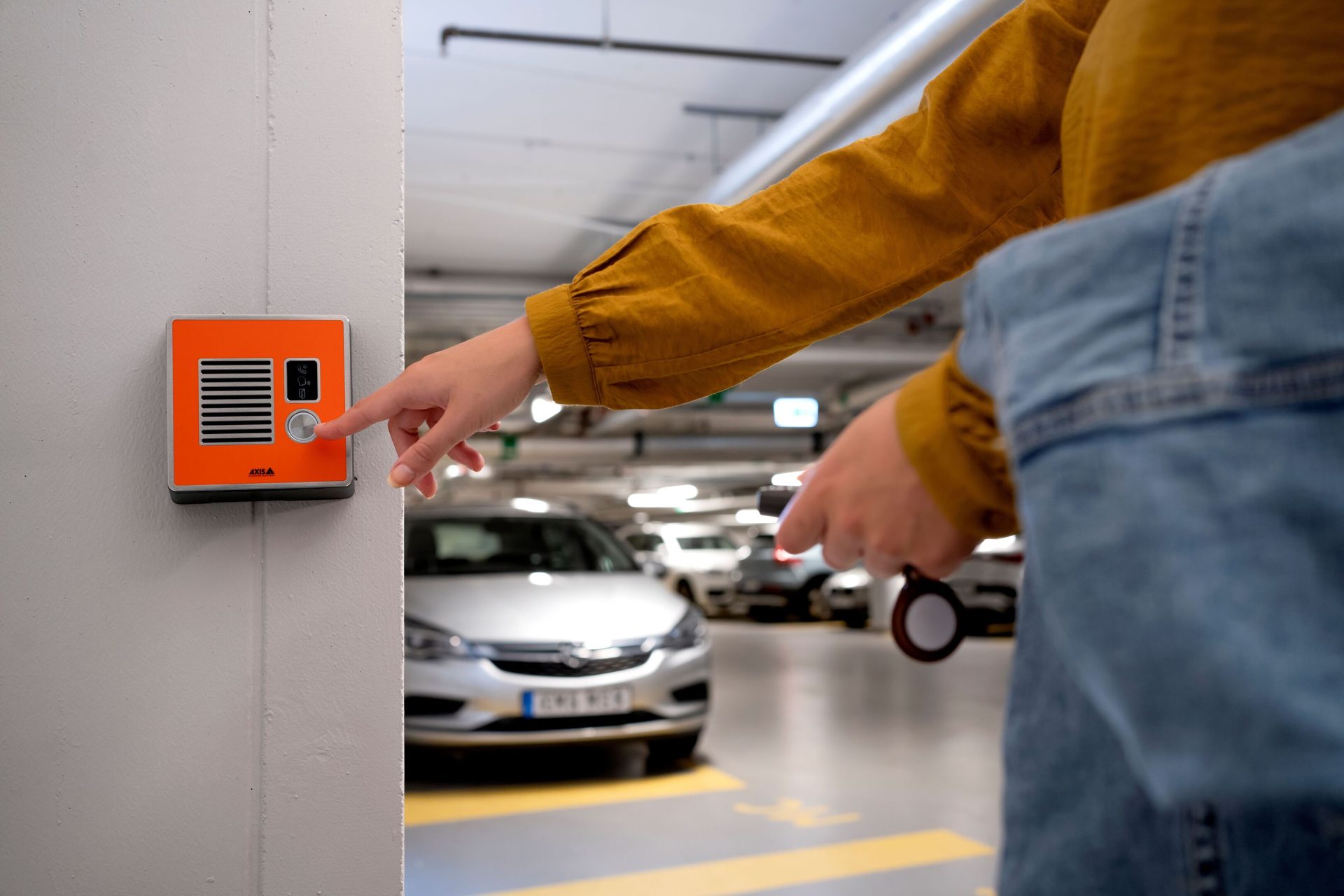
Noise reduction and echo cancellation are intercom features that process the audio and filter out background noise and echoes — as might be present in a parking garage — so that the speaker’s voice can be more clearly heard above the sound of motors and other noise. Image courtesy of Axis Communications
SHARE
Unclear audio during intercom use can easily turn routine communication into a source of frustration. Whether it’s an incomprehensible recorded announcement about store hours or an unsuccessful voice request for help with a malfunctioning gate, poor audio quality disrupts clarity and leaves users questioning the system’s usefulness.
For end users, these experiences may prompt skepticism about the value of investing in an intercom system. For security integrators, they raise a more serious question: How can you ensure that the intercom systems you specify, install, and support will provide your customers with optimal performance? Achieving consistent audio clarity requires thoughtful selection of products and meticulous planning of the installation so that it suits the acoustic conditions of each environment.
“If you’re going to buy an intercom and install it, it’s really pointless if it can’t be used for what it’s designed for, which is to communicate,” says Diane Ritchey, marketing director, safety and security, Americas, Zenitel, Kansas City, Mo. “It’d be like buying and installing a video camera and you don’t have clear images.”
Audio performance in building intercom systems is a key factor in security operations. An article on Zenitel’s website, titled “3 Cs of Audio Quality: Designing Intercoms for Real-World Noise,” points out: “A simple misunderstanding due to poor sound can lead to security breaches, unauthorized entry, or even dangerous situations.”
The three Cs that Zenitel espouses — crispness, clarity, and conciseness — are primary attributes that support effective communication in intercom systems, especially in acoustically challenging environments, says Dan Rothrock, senior vice president of global business development at Zenitel.
Similar to how integrators evaluate surveillance cameras by doing a “shootout,” they should evaluate intercoms, Rothrock advises. This is especially important among units that have similar specifications “so that they can understand the audio difference between the devices that they’re thinking about putting in,” he says. “Making that investment on the front end can save them so much money on the back end.”
An in-depth study of the intercom’s mechanics, hardware, and software should be part of their overall selection process, Rothrock says. Some of the answers integrators need may be found by questioning manufacturers about things like how they source the intercom’s materials and construction methods.
“If you’re going to buy an intercom and install it, it’s really pointless if it can’t be used for what it’s designed for, which is to communicate. It’d be like buying and installing a video camera and you don’t have clear images.”
— Diane Ritchey, Zenitel
Beyond the Call: Innovative Uses for Modern Intercom Technology
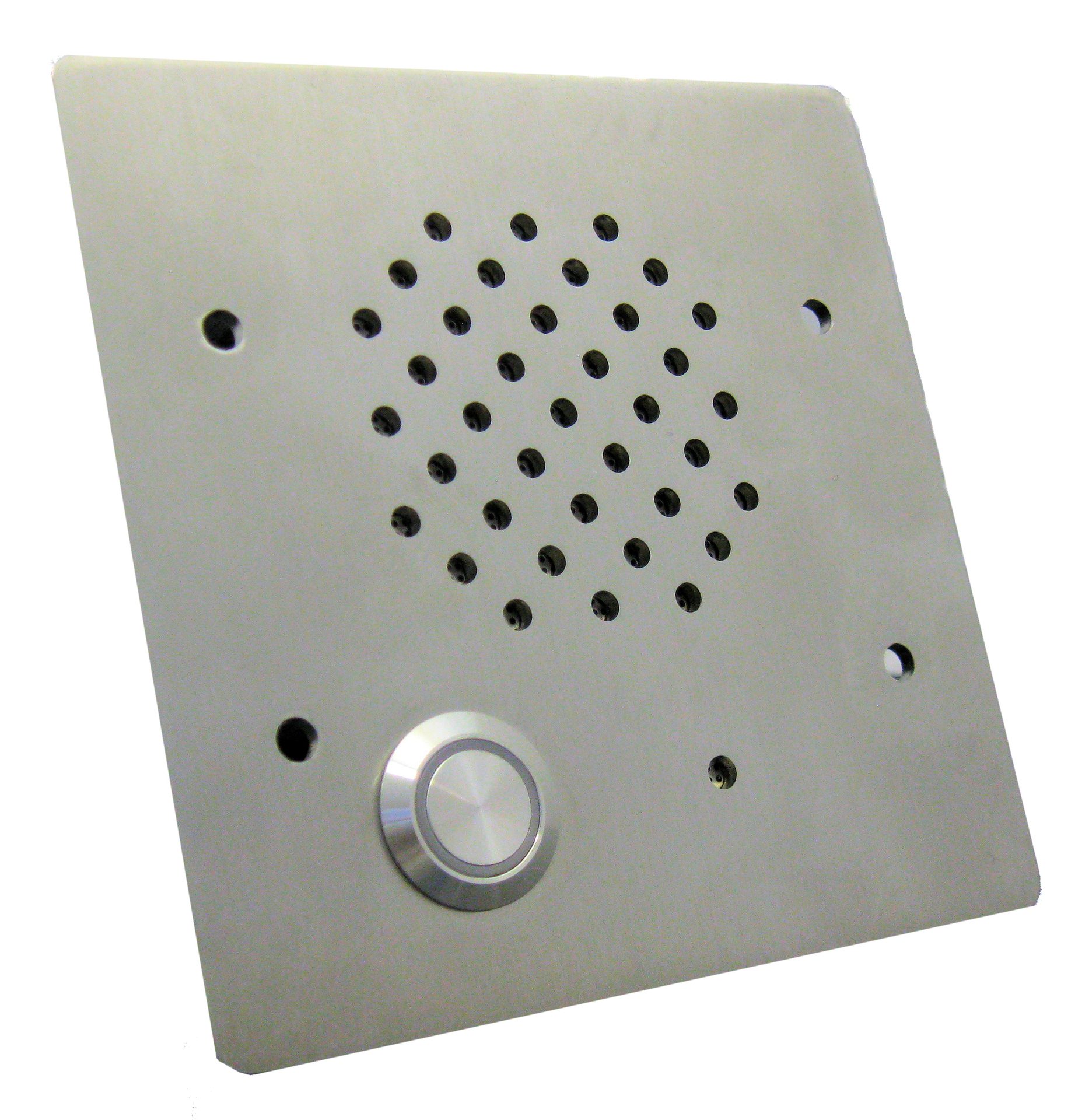
Unlocking the Potential: Digital Acoustics Intercoms Meet PA & Access Control
Digital Acoustics’ intercoms support timed audio messaging solutions in retail environments around the world. In one high-volume implementation, an integrated security intercom and public address system delivers more than one million automated messages each month for a single customer across 5,000 store locations. These include announcements such as “Store closing in 15 minutes,” “Thank you for shopping,” and pandemic-era guidance on social distancing, demonstrating how a single integrated solution can serve multiple operational needs.
In another nationwide deployment, a client with retail stores across the U.S. leverages Digital Acoustics’ hardware and software to ensure compliance with a safety policy prohibiting back doors from being propped open. When a sensor detects that the back door is ajar, a pre-recorded message immediately plays, instructing staff to close it — reinforcing protocol without human intervention. Image courtesy of Digital Acoustics

Axis 2N Intercoms Keep Convenience & Security in Check
Technology from Axis Communications plays a crucial role in powering dozens of Aisle 24 convenience stores, which operate entirely on a self-service, cashier-free model. Initially launched in Ontario and Quebec, Canada, these stores are equipped with Axis cameras, mini speakers, and 2N intercoms to ensure shopper safety and secure inventory and property. Most locations range from 1,200 to 1,800 square feet, though some compact sites are as small as 350 square feet.
Customers access the stores via a mobile app, which handles registration, store entry, and checkout. Once registered and ready to shop, customers press an icon in the app that activates the intercom via Bluetooth to unlock the outer door. Inside the vestibule, a second intercom displays a “WAIT” message until the outer door closes and locks. Once secure, the inner intercom signals “UNLOCKED,” allowing entry into the store — no physical contact with the intercoms is required. Plans are underway to add voice-guided instructions to further streamline the experience.
This unattended model also supports vendor access for restocking. Suppliers can independently enter stores by inputting a unique PIN code on the intercom system. Unique video surveillance cameras and placement complement the experience. Image courtesy of Aisle 24
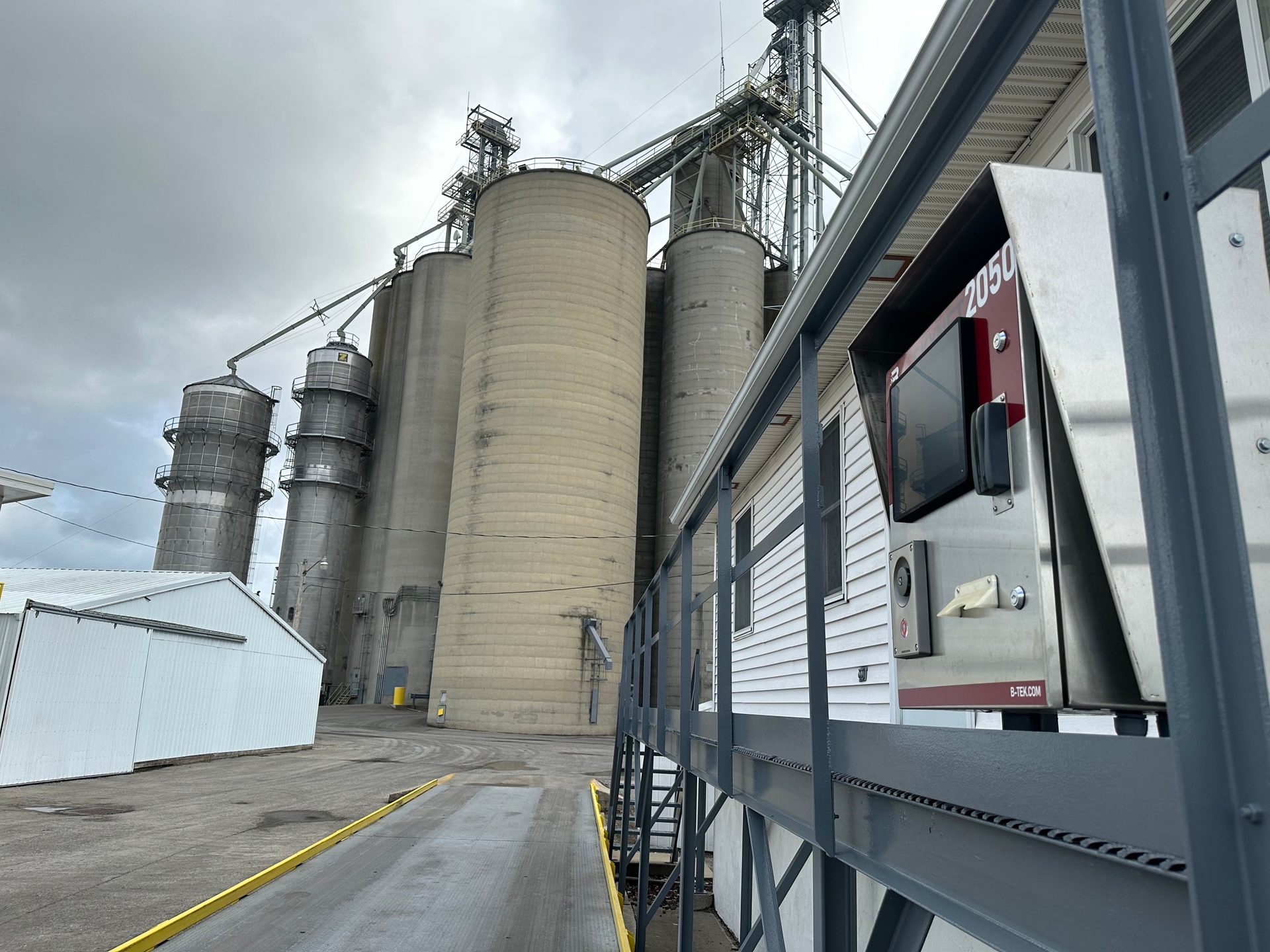
Zenitel Streamlines Truck Scale Logistics With Clear Intercom Audio
Truck scales are used across industries such as recycling, agriculture, and manufacturing to determine how much material is being picked up or delivered based on net vehicle weight, which helps in calculating proper compensation. For B-TEK Scales, ensuring accurate weight readings meant enabling reliable two-way communication between truck drivers and scale operators.
These weigh stations often operate in noisy outdoor environments, where diesel engines and weather conditions can interfere with audio clarity. To address this, B-TEK chose Zenitel’s noise-cancelling, weather-resistant intercoms. These units deliver strong, clear audio — up to 105 dB — and automatically adjust for background noise using built-in features such as noise reduction, auto volume control, and auto gain control. Drivers can remain in their trucks, maintaining safety, while operators can clearly hear the drivers and relay instructions to them.
Inside the office, operators use Zenitel’s ITSV-4 IP Desk Video Intercom with a 5-inch screen to manage communication with drivers at the outdoor kiosks. In some installations, B-TEK also adds accessories like station backboxes and windscreens, which improve sound clarity in windy or open areas.
Together, these integrated technologies streamline logistics, reduce miscommunication, and ensure smooth operations, even in demanding environments. Image courtesy of Zenitel
Mechanics, Hardware & Software
One example of mechanics is looking at how a manufacturer isolates the intercom’s speaker and microphone(s) from one another to prevent feedback. “If you have a speaker and a microphone close together and you’re having an open conversation, while I’m talking into the microphone, the speaker may be putting sound out, and the sound that comes out of the speaker is going right back into the microphone. It’s creating a loop, which is going to create feedback — and you don’t want that,” Rothrock explains.
“On a small form factor intercom, it might be the maximum distance physically possible. But, if so, there are other methods that manufacturers can use to prevent feedback. For one, they can introduce isolation around the microphone so that the vibration in the hardware, as the speaker is moving, doesn’t transmit to the microphone,” he says.
It may be difficult to evaluate the speaker and microphone independently; however, doing a shootout in which you appraise their sound will indicate if they are of good quality. Security integrators should ask manufacturers if the speaker has been properly matched — not only by power, but by impedance — for the best voice quality when tied to the amplifier.
Rothrock suggests asking: “Am I using an amplifier that is the most efficient for the amount of network power I can get in an IP device? Is it putting out enough power that it can make the device loud enough, no matter what the dynamic situation around it is or how loud it gets?”
The best way to know is to set up intercoms side by side, turn up their volume, “and see how loud it will get and still maintain that crisp, clear audio,” he says. “You want to push it to its limits in your environment.” The intercom’s specification sheet should provide the sound pressure level (SPL) or decibel (dB) output.
Two ratings that integrators should look for when selecting an intercom are its IP rating and its IK rating. “The majority of intercoms are on the exterior of a building,” says Dom Albano, program manager, intercoms, Axis Communications, Chelmsford, Mass. “You can have good performance, but if the performance is impeded by weather and vandalism, then the intercom doesn’t last.”
The ingress protection (IP) rating grades how well an enclosure such as an intercom resists dust and liquid intrusion. The first digit (on a scale from 0 to 6) indicates protection against solids like dust, while the second (on a scale from 0 to 9) reflects resistance to water, from light splashes to high-pressure jets.
Albano says many intercom units now feature IP65 or IP66 ratings (the highest possible is IP69). “You might have an intercom somebody installs with no IP rating, but they say it’s outdoor rated,” Albano says. “What if I’m pressure-washing the building and suddenly now the microphone doesn’t work, or the speaker doesn’t work because it wasn’t rated?”
The IK rating designates how well enclosures for electrical equipment are protected against external mechanical impacts, such as being hit with a hammer. The rating scale goes from 00 to 10. “What I’ve seen, particularly with touchscreen intercoms, is IK8. If you can get IK8, that’s a very good rating for impact-resistance on those intercoms,” Albano suggests.
He recommends using an intercom with a hardwired connection for best performance. “[It’s] just a network cable that plugs in as opposed to a Wi-Fi based intercom,” he says, adding that Wi-Fi based intercoms may be adversely affected by the use of illegal jammers, dropped wireless signals, and other devices that compete for the same frequencies. A hardwired unit is more secure, Albano says.
Audio codecs direct how the digital audio is compressed and decompressed, while maintaining audio quality. The codecs are often driven by the frequency range of the intercom.
Wideband or HD audio, which uses a larger frequency range, creates a fuller, more natural sound because it delivers the full spectrum of the voice frequencies, Albano describes. “Some examples of these codecs are G.722, Opus, and Advanced Audio Codec (AAC),” he says, adding that it’s the latest technology. “When we see these, that means you should be getting that fuller frequency range, that more natural sound.”
Some intercoms may offer a range of different codecs, while others may only offer a narrowband codec, such as G.711. It has a limited frequency range and sounds more like the audio found on a traditional landline phone, Albano says. Some intercoms use the G.729 codec. It is similar to G.711 narrowband, but it has a very low bit rate for applications in which the network is weak and doesn’t offer enough bandwidth and when access to 5G is limited.
Codec compatibility is an important consideration. In some cases, you’ll need an intercom that supports multiple formats, while in others, a single option — such as G.711 narrowband — may meet the application's requirements.
While audio clarity is a paramount factor in intercom selection, the system also should work well over the network, explains Charles Nguyen, product marketing manager – video, audio, and analytics, Montreal-based Genetec. “Features like bandwidth control, priority for audio traffic, and backup options help keep communication reliable, even during network slowdowns,” he explains.
Other features Nguyen says are helpful in achieving best performance are full-duplex functionality (both sides can talk at the same time), echo reduction, and noise cancellation — helping people hear each other clearly, even in loud or outdoor areas.
“The majority of intercoms are on the exterior of a building. You can have good performance, but if the performance is impeded by weather and vandalism, then the intercom doesn’t last.”
— Dom Albano, Axis Communications
Since most intercoms are installed outdoors, look for listings and ratings that designate resistance to high and low temperatures, water, impact and vandalism, and more. Image courtesy of Zenitel
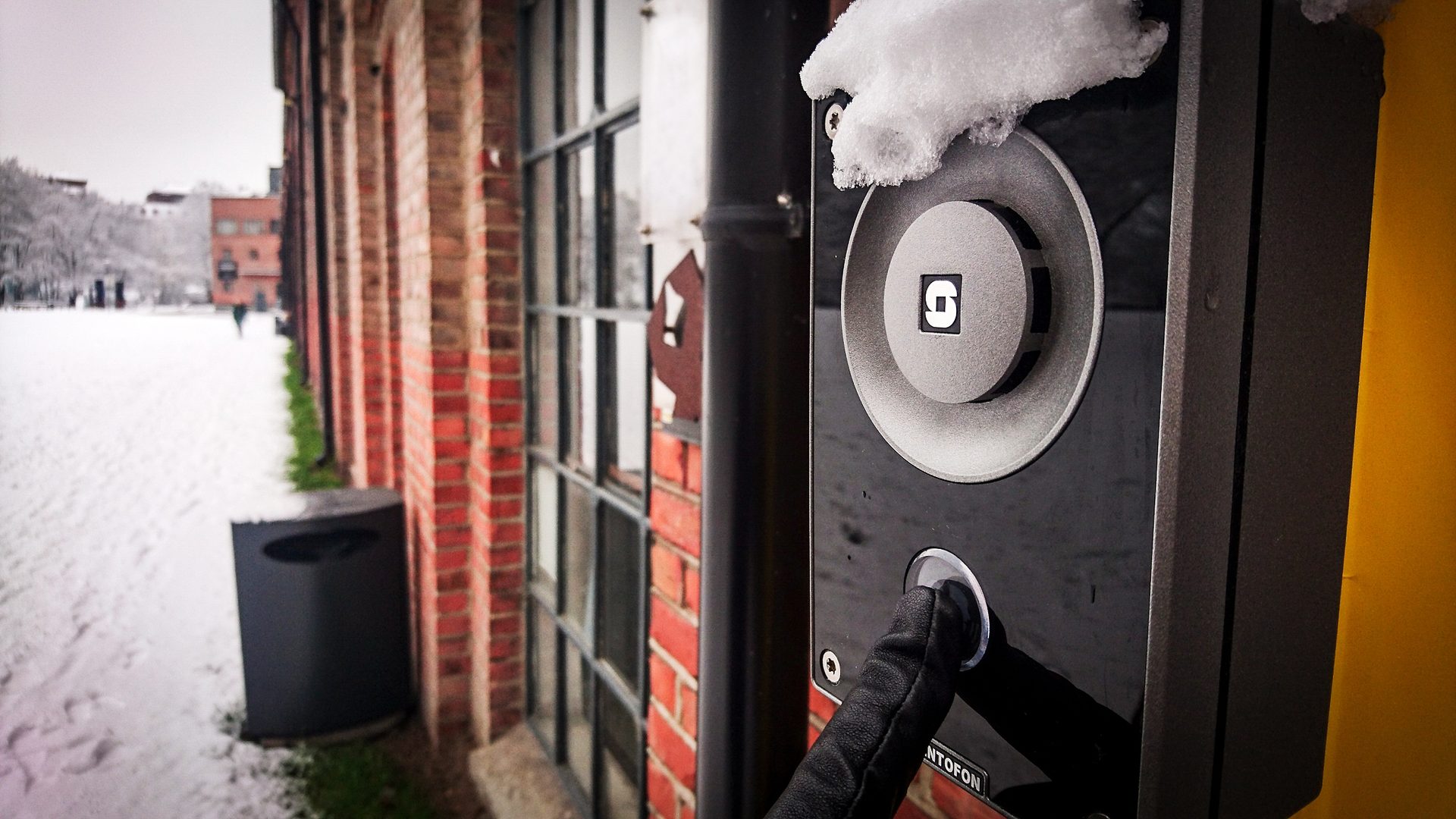
Many intercoms today are used for surveillance and access control, in addition to two-way communication, so it’s important to consider the features of the camera and its ability to view scenes exposed to glare as well as low light. Image courtesy of Axis Communications
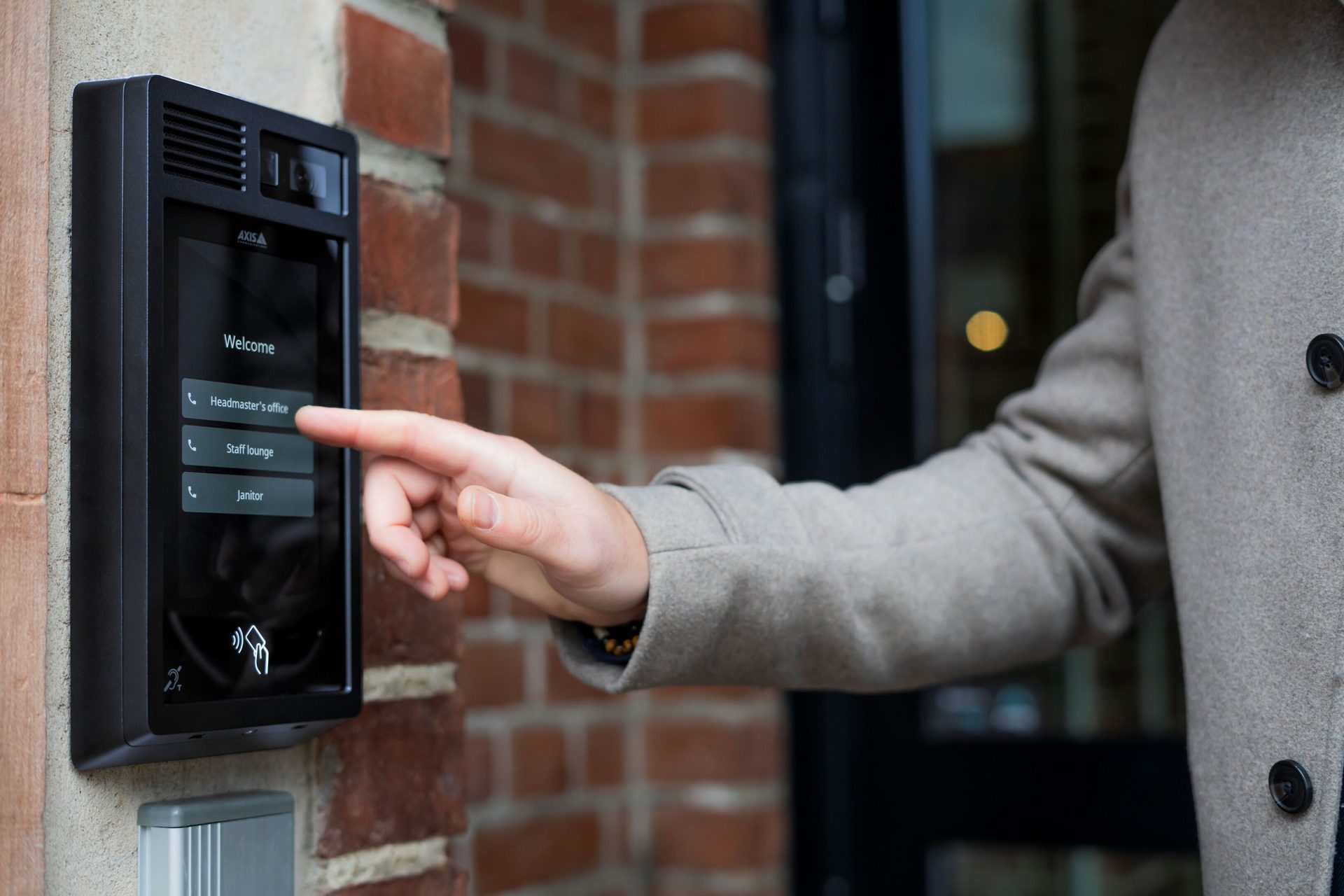
Achieving Optimal Audio Clarity
Different manufacturers may use different designations, but, generally, features such as noise reduction, echo cancellation, automatic gain control, and similar ones are designed to filter out unnecessary noise and improve the quality of the audio.
“The most routine example someone would see is you’re on an intercom outside of the building and the lawn maintenance crew is there, leaf blowing or mowing,” Albano says. “It might be loud for the person at the intercom, but noise reduction/noise cancellation usually does a really good job in that type of environment, filtering out the leaf blower or the noises like that.”
To cancel extraneous noise, manufacturers may use dual beamforming microphones, which narrow in on the person in front of the intercom and segment that audio from the background noise. Or they may use algorithms that focus on the constant sound, such as a lawn mower, and remove it.
Echo cancellation works well in areas that have solid walls or surfaces that bounce sound around. This feature analyzes the voice that is speaking and, if it recognizes the same sounds — as in an echo — it removes the repeating occurrences.
When a feature called automatic gain control (AGC) detects high noise levels, it can automatically raise the volume of a speaker while the noise level is present, and then automatically return it to a normal level when the background noise ceases. Similarly, if someone is speaking too loudly through the microphone, the intercom system will lower the volume, auto-adjusting based on whether someone is shouting or talking.
Another feature is dynamic range compression (DRC). Unlike AGC, which adjusts overall volume based on ambient noise, DRC targets specific sound elements — raising soft tones and lowering loud ones, much like adjusting the sound intensity of musical instruments in a recording studio.
“We take the peaks and valleys out and we can actually shape the sound,” Rothrock explains. “So, if a person’s voice is low, by dynamic range compression, you can shape the sound and make those quiet sounds louder. That’s really important in an intercom that’s being challenged at the door.”
Echo Cancellation & Noise Reduction Explained
Daniel Lindsay of Digital Acoustics outlines two key performance features in intercom systems, explaining how they function within his company’s products — and likely in similar ways across other manufacturers. These technical details are essential for security integrators to discuss with their vendors, especially to confirm that the solutions they deploy can perform reliably in noisy environments.
In security intercom systems, ensuring fluid and natural communication — especially during critical security events — requires more than just good audio hardware. One essential component is full-duplex echo cancellation. Unlike half-duplex setups, where one person must wait for the other to finish speaking before they can speak (like a walkie-talkie), full-duplex systems allow both parties to speak and listen simultaneously. This creates a more natural, real-time conversation experience.
Echo cancellation plays an important role here. The analogy Lindsay gives is when using a car’s hands-free system, your voice travels through the microphone while the other person’s voice comes through the speakers. Despite being in the same acoustic space, they don’t hear themselves echoing back. That’s because the system detects the outgoing audio and digitally removes it from the incoming signal before it reaches the other party.
The most advanced echo cancellation systems go further. They buffer the outbound audio and trace multiple “echo paths,” which are routes audio can take as it bounces off walls or nearby surfaces and back into the microphone. Sophisticated algorithms identify up to four or five such paths and eliminate those signals with precision, preserving only the incoming voice. This ensures both clarity and responsiveness, even in noisy or acoustically complex environments.
Clean echo cancellation also depends on speaker consistency; the more uniform the sound emitted, the more effectively the system can recognize and remove its reflection before it’s picked up again.
Noise reduction in security intercom systems is more than just quieting background sounds. It’s about intelligently isolating the human voice from chaotic environments. The system listens to the audio stream coming through the microphone and identifies persistent sound signatures like the hum of a truck engine or an air conditioning unit. It then creates real-time algorithms that “notch out” those consistent frequencies, erasing them from the signal. While some of those might overlap slightly with voice frequencies, the human brain is a really good digital signal processor that compensates and fills in the gaps, delivering speech that sounds natural, Lindsay says.
In contrast to tightly controlled environments, security installations are unpredictable and varied. Therefore, their technology relies on a dedicated digital signal processor to quickly adapt to each specific environment.
Integration Capabilities Give Users More Value
Intercom technology has evolved far beyond basic two-way voice communication. Today’s systems are capable of operating across a broad ecosystem of platforms, offering a wide variety of integration options. Some intercoms use open standards, making it possible to integrate with tools such as Zoom, Microsoft Teams, Cisco PBX, and traditional desk phones.
Session Initiation Protocol (SIP)-based intercoms integrate seamlessly with telephony systems, enabling calls to multiple phones, mobile devices, and external numbers, among other things. This feature can enhance security in applications where hundreds of intercoms are managed by a team of receptionists or where even more are monitored by central station operators, providing the option for the intercom calls to display as alerts on the monitoring platform and/or ring in directly to operators’ phones, says Daniel Lindsay, senior engineer, Digital Acoustics, Des Plaines, Ill. Additionally, retail employees can dial an extension of an individual intercom to make an announcement through it.
One of the key decisions when selecting an intercom system is identifying how far the integrations should extend. Is the goal simply to connect with a single endpoint, or should the intercom interface with mobile apps, video management systems, and broader network infrastructure? Systems that support open protocols such as ONVIF Profiles S and T can incorporate features like two-way audio and remote door release directly through third-party VMS platforms, Albano says. Increasingly, intercoms also incorporate access control features, such as embedded card readers and even QR codes, he adds.
Lindsay says a natural integration is between an intercom and public address. “You’re only buying one piece of equipment, or one software license, or one subset of equipment in order to perform two tasks,” he says, adding that the same line of thinking can be extended to access control.
One of the company’s applications in retail uses the intercom/PA system to automatically broadcast voice-down messages on a set schedule. It translates to billable recurring revenue for the central station that is monitoring the intercoms. Another recurring revenue opportunity is streaming music through intercom devices, Lindsay says.
Ultimately, if you can find an audio solutions manufacturer that will take the time to answer questions about the product’s build, lend equipment for an intercom shoot-out, and go through the pre-sales process with you by providing equipment demos for your customers’ various applications, that’s a big positive, Lindsay says.
While clarity-enhancing features give your customer an audio system that will both work well and last a long time, integrations with external technology will give them a solution that is valuable and can lower costs over time.
Video Intercoms: Some Camera Features That Perform
For the video portion of an intercom, integrators should select a unit with at least a 2-megapixel camera, advises Dom Albano of Axis Communications. In some cases, however, better resolution cameras such as 4K may be desirable, as they can be leveraged for tasks other than communication. For example, if the intercom is located at the front of a building near a parking lot, users can digitally zoom in to watch situations that may be occurring in the background.
Another feature that is useful on the camera portion of an intercom is wide dynamic range (WDR) because it helps to overcome backlighting. Bright sunlight behind a person standing in front of the intercom can put them into a shadow that prevents them from being viewed. WDR can also help overcome the bright headlights of a vehicle in an adjacent parking spot placing a person at the intercom in darkness, for example.
“With wide dynamic range, the camera is taking two pictures at different exposure rates — one is going to be under-exposed, and one is over-exposed — and it will actually combine these two to create one picture,” Albano says. “So then you can actually see the person’s face, and you can see whatever is in the background; it won’t be washed out.” He adds that some companies may call it high dynamic range.
If the intercom lacks this feature, you can try alternative solutions, such as mounting it at an angle using a tilted bracket or installing it on a standalone pedestal away from the building. Positioning the intercom strategically can help prevent direct sunlight from hitting the device.
To also enhance the performance of the video portion of an intercom, some manufacturers incorporate bright white lights to better illuminate the user’s face. Other intercoms include low-light performance functionality, which makes very low-light scenes visible in high-resolution full color, Albano says.
SHARE

